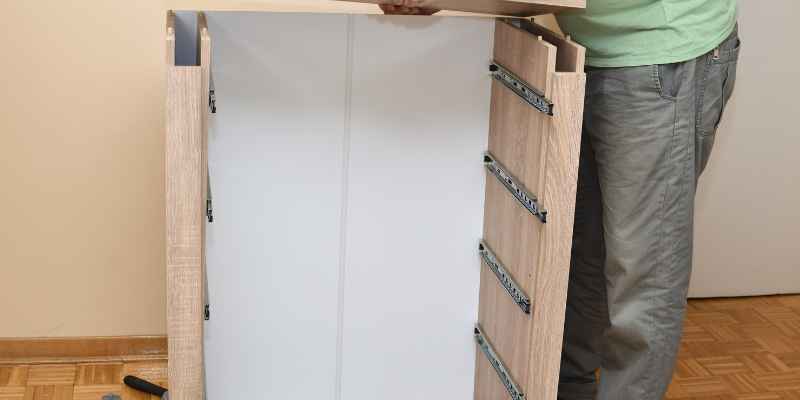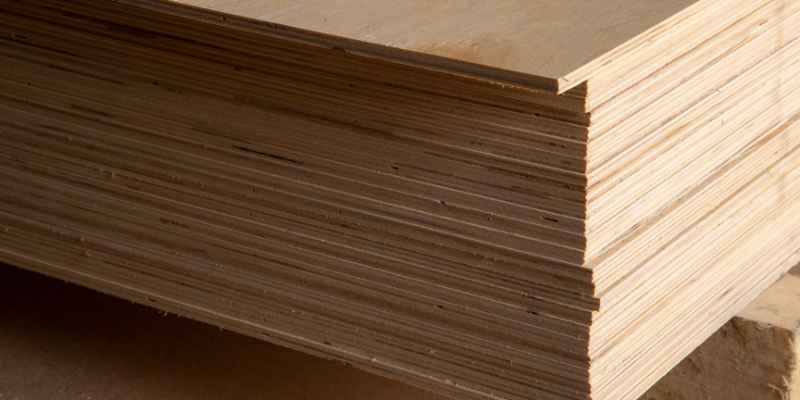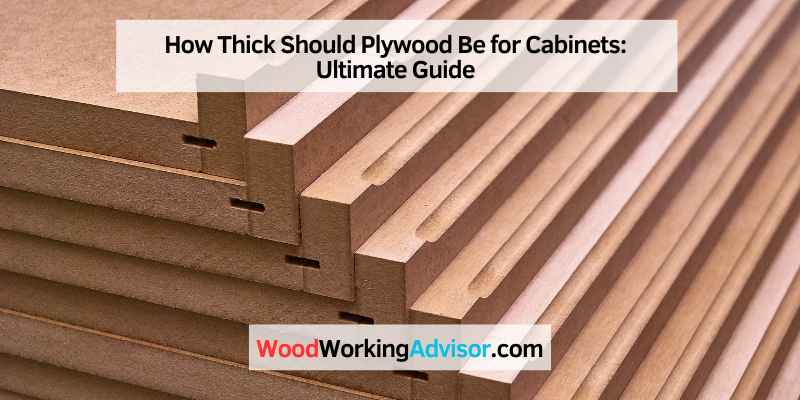Plywood for cabinets should typically be around 1/2 inch to 3/4 inch thick. This thickness provides the necessary stability and strength for cabinet construction.
When choosing the right plywood thickness for cabinets, it is essential to consider the weight-bearing capacity and durability required for the specific cabinet design. Thicker plywood is generally more suitable for heavy-duty cabinets or those that will be subjected to significant weight loads.
Additionally, the plywood thickness should also be determined by the size of the cabinet and the span of the shelves. Larger cabinets or those with longer shelf spans may require thicker plywood to prevent sagging or structural issues. By carefully considering these factors, you can select the appropriate plywood thickness for your cabinet project, ensuring its longevity and functionality.
Introduction To Plywood Cabinet Construction
Benefits Of Using Plywood
Plywood is a popular choice for cabinet construction due to its durability, strength, and versatility. It offers excellent resistance to warping, cracking, and twisting, making it ideal for long-lasting cabinet structures. Additionally, plywood is available in various grades, allowing for customization based on the specific needs of the cabinet project.
Plywood Vs. Other Materials
When compared to other materials such as particleboard or MDF, plywood stands out for its superior strength and resistance to moisture. It is also lighter than particleboard, making it easier to work with during cabinet assembly. Furthermore, plywood provides a more stable base for hardware and hinges, enhancing the overall functionality of the cabinets.
Plywood Thickness Basics
Choosing the right plywood thickness for cabinets is crucial in ensuring their durability and functionality. The thickness of plywood used for cabinet construction can vary based on several factors, including the specific application and the overall design of the cabinets. In this article, we’ll explore the essential considerations for determining the ideal plywood thickness for cabinets.
Standard Plywood Thicknesses
Standard plywood thicknesses commonly used for cabinet construction range from 1/4 inch to 3/4 inch. The most popular choices include 1/2 inch and 3/4 inch plywood, offering sufficient strength and stability for cabinet applications. However, the specific thickness required may vary depending on the size and intended use of the cabinets.
Factors Influencing Thickness Choice
- Size of the Cabinets
- Weight-Bearing Capacity
- Door and Drawer Hardware
- Overall Design and Style
When determining the appropriate plywood thickness, it’s essential to consider the size of the cabinets and the weight they will bear. Additionally, the type of hardware used for doors and drawers, as well as the overall design and style of the cabinets, can influence the thickness selection. By carefully evaluating these factors, you can ensure that the chosen plywood thickness aligns with the specific requirements of your cabinet project.
Wall And Upper Cabinets Considerations
When it comes to wall and upper cabinets, the thickness of the plywood used is crucial for ensuring stability, weight capacity, and proper mounting. Here are the key considerations for selecting the right plywood thickness for wall and upper cabinets:
Recommended Thickness For Stability
The recommended plywood thickness for wall and upper cabinets is 3/4 inch. This thickness provides the necessary stability to support the weight of the cabinet and its contents while ensuring durability and longevity.
Weight And Mounting Implications
Using 3/4 inch thick plywood for wall and upper cabinets allows for adequate weight-bearing capacity, ensuring that the cabinets can safely support the items stored inside. Additionally, this thickness provides a secure base for mounting the cabinets on the wall, minimizing the risk of sagging or structural issues over time.
Base Cabinets And Shelving
For base cabinets and shelving, plywood thickness for cabinets should be at least 3/4 inch for stability and durability. Thicker plywood, such as 1 inch, can be used for heavier loads or larger spans. It’s important to consider the weight and purpose of the cabinets when determining the plywood thickness.
When it comes to building cabinets, the thickness of the plywood used can have a significant impact on the durability and strength of the finished product. Base cabinets and shelving are two areas where choosing the right plywood thickness is crucial. Here, we’ll explore the optimal thickness for durability and supporting heavy countertops.
Optimal Thickness For Durability
The thickness of the plywood used for base cabinets and shelving will depend on the size of the cabinet and the load it will bear. Generally, 3/4-inch plywood is the standard thickness used for base cabinets and shelving, providing adequate support for most applications. However, if you’re building larger cabinets or need to support heavier loads, you may want to consider using thicker plywood.
Supporting Heavy Countertops
When it comes to supporting heavy countertops, the thickness of the plywood used is even more critical. A thicker plywood will provide better support for the weight of the countertop, preventing it from sagging or bowing over time. For countertops made of heavy materials such as granite or quartz, 1 1/2-inch plywood is recommended.
It’s also essential to ensure that the plywood used for supporting heavy countertops is of high quality and free from defects such as knots or voids. These imperfections can weaken the plywood and compromise its ability to support heavy loads.
In conclusion, choosing the right plywood thickness for base cabinets and shelving is crucial for ensuring the durability and strength of your cabinets. By selecting the appropriate thickness, you can ensure that your cabinets will be able to bear the load they’re intended to carry and provide years of reliable service.
Specialty Cabinets And Usage
Specialty cabinets serve specific purposes in a kitchen, such as drawers, pull-outs, and glass-front cabinets. The thickness of plywood used for these cabinets depends on their intended usage.
Thickness For Drawers And Pull-outs
Drawers and pull-outs require 3/4 inch thick plywood to ensure sturdiness and durability.
Considerations For Glass-front Cabinets
- For glass-front cabinets, 1/2 inch thick plywood is suitable for a lighter weight.
- Use tempered glass to increase safety in glass-front cabinet construction.
Material Grades And Quality

Identifying High-quality Plywood
High-quality plywood for cabinets has smooth surfaces and minimal defects.
It is strong, durable, and resistant to moisture and warping.
Grade Impact On Thickness
Plywood grades impact the thickness consistency and overall quality.
Higher grades often have more uniform thickness and fewer imperfections.
Lower grades may vary in thickness and have more visible flaws.
Working With Plywood
For cabinets, the ideal plywood thickness ranges from 1/4 inch to 3/4 inch, depending on the cabinet’s purpose and the weight it needs to support. Thicker plywood is suitable for base cabinets and countertops, while thinner plywood is ideal for the cabinet backs and sides.
Always consider the cabinet’s intended use and load requirements when selecting plywood thickness.
When it comes to building cabinets, selecting the right thickness for plywood is crucial. Plywood thickness determines the strength and durability of the cabinets. If you are working on a DIY project, it is vital to understand the cutting techniques, joinery, and assembly to ensure that your cabinets are sturdy and long-lasting.
Cutting Techniques
Cutting plywood can be challenging, especially if you are not using the right tools. A circular saw or a table saw with a fine-toothed blade is ideal for cutting plywood sheets. It is essential to use a straightedge or a guide to ensure that your cuts are straight and accurate.
If you don’t have access to a saw, you can use a jigsaw or a handsaw, but the cuts may not be as precise. It is also crucial to use a sharp blade to prevent splintering and ensure clean cuts.
Joinery And Assembly
Joinery and assembly are critical to the strength and durability of your cabinets. There are several ways to join plywood sheets, including butt joints, rabbet joints, and dado joints.
Butt joints are the simplest and easiest to make, but they are not as strong as other types of joints. Rabbet joints and dado joints, on the other hand, provide more stability and strength to the cabinet.
When assembling the cabinets, it is crucial to use wood glue and clamps to hold the pieces together. It is also essential to use screws or nails to secure the joints and prevent the cabinet from falling apart.
In conclusion, working with plywood requires the right tools, cutting techniques, and joinery and assembly methods. By following these tips, you can create sturdy and long-lasting cabinets that will add value and beauty to your home.
Finishing And Aesthetics
For cabinets, plywood should be at least 3/4 inch thick to provide ample strength and stability. Thicker plywood, such as 1 inch, may be used for added durability and a more substantial feel. The thickness of the plywood directly impacts the overall quality and longevity of the cabinet construction.
Surface Preparation
Before applying any finishing on the plywood, it is essential to prepare the surface properly. The surface should be smooth, clean, and free from any dust or debris. Sanding the plywood with a fine-grit sandpaper will remove any rough spots and ensure that the surface is even. Wipe the surface with a damp cloth to remove any dust or debris. This step is crucial to achieving a smooth and flawless finish.
Finishing Options For Durability
Plywood cabinets can be finished with various options for durability. The most popular finishing options are paint, stain, and varnish. Paint can be used to achieve a solid color finish that is easy to clean. Stain is a popular choice for those who want to enhance the natural beauty of the wood grain. Varnish is a clear finish that provides excellent protection against wear and tear.
Paint
Paint is a popular finishing option as it provides a smooth and even finish. It is easy to clean and maintain and is available in a wide variety of colors. For best results, use a primer before painting the plywood to ensure that the paint adheres properly.
Stain
Stain is a popular choice for those who want to enhance the natural beauty of the plywood. It is available in a wide variety of colors and finishes, from light to dark. Stain can be applied with a brush, rag, or spray gun. For best results, use a wood conditioner before applying the stain to ensure an even finish.
Varnish
Varnish is a clear finish that provides excellent protection against wear and tear. It is available in gloss, semi-gloss, and satin finishes. Varnish can be applied with a brush, roller, or spray gun. For best results, use a sanding sealer before applying the varnish to ensure that the finish adheres properly.
In conclusion, the thickness of the plywood used for cabinets is an essential consideration. However, finishing the plywood is equally important to ensure durability and aesthetics. By properly preparing the surface and selecting the appropriate finishing option, you can achieve a flawless and long-lasting finish for your plywood cabinets.
Plywood Cabinet Maintenance

Routine Care Tips
Wipe with damp cloth. Use mild soap if necessary.
Avoid harsh chemicals. Dry immediately after cleaning.
Long-term Durability Strategies
Apply protective coating every few years.
Check for signs of wear. Repair promptly if needed.
Cost Considerations
Consider the purpose and load-bearing capacity when determining plywood thickness for cabinets. Typically, 3/4-inch plywood is a popular choice for cabinet construction due to its strength and durability. However, for smaller cabinets or shelves, 1/2-inch plywood may be suitable while heavier-duty cabinets may require 1-inch thickness.
Balancing Quality And Budget
When choosing plywood for cabinets, it’s crucial to find a balance between quality and budget.
Price Differences By Thickness
Cost considerations play a significant role in determining the thickness of plywood for cabinets.
Thicker plywood is more durable but comes at a higher cost.
Thinner plywood is more budget-friendly but may lack in strength.
Environmental And Safety Concerns
Plywood thickness for cabinets should be determined by considering both environmental and safety concerns. It is important to choose a thickness that can withstand the weight and stress of the cabinet contents while also being environmentally friendly in terms of sustainable sourcing and low emission levels.
By striking the right balance, you can ensure both durability and responsible construction practices.
When it comes to building cabinets, choosing the right plywood thickness is essential. However, it’s not just about the thickness of the plywood; environmental and safety concerns are also significant factors to consider.
Eco-friendly Plywood Options
If you’re looking to use eco-friendly plywood options, you’ll be happy to know that they are readily available. One such option is bamboo plywood, which is sustainable and easy to work with. Another option is wheatboard plywood, which is made from wheat straw and is formaldehyde-free.
Health Considerations With Plywood
Plywood can contain chemicals like formaldehyde, which can be harmful to your health. It’s essential to choose a plywood that has low formaldehyde emissions or is formaldehyde-free. Additionally, wearing protective gear like a mask and gloves while working with plywood is recommended.
Table: Plywood Thickness Guide for Cabinets
| Cabinet Component | Plywood Thickness |
|---|---|
| Sides, Tops, and Bottoms | 3/4 inch |
| Backs | 1/2 inch |
| Drawers | 1/2 inch or 5/8 inch |
As you can see from the table, the plywood thickness for cabinets varies depending on the component. It’s important to choose the right thickness for each component to ensure that the cabinets are sturdy and durable.
In conclusion, when building cabinets, it’s crucial to consider environmental and safety concerns. Choosing eco-friendly plywood options and wearing protective gear while working with plywood can help minimize any negative impact on the environment and your health. Additionally, choosing the right thickness for each component is essential to ensure that the cabinets are durable and long-lasting.
Frequently Asked Questions
What Is The Standard Plywood Thickness For Cabinets?
The standard plywood thickness for cabinets is typically 3/4 inch. This thickness provides the necessary sturdiness and durability for cabinet construction while allowing for easy installation of hardware and hinges.
Can Cabinets Be Made With Thinner Plywood?
While cabinets can be made with thinner plywood, it is not recommended for durability and strength. Thinner plywood may not withstand the weight of items stored inside the cabinets or the stress of daily use, leading to potential damage and a shorter lifespan.
What Are The Advantages Of Using Thicker Plywood For Cabinets?
Using thicker plywood for cabinets offers increased durability, better resistance to warping, and enhanced stability. Thicker plywood also provides a solid base for attaching hardware and ensures the longevity of the cabinets even with heavy usage.
How Does Plywood Thickness Affect Cabinet Cost?
The thickness of plywood can impact cabinet cost as thicker plywood tends to be more expensive than thinner options. However, investing in thicker plywood for cabinets can result in higher quality, longer-lasting cabinets that may require less maintenance over time.
Conclusion
To ensure sturdy and durable cabinets, selecting the right thickness of plywood is essential. By considering factors such as cabinet size, weight-bearing capacity, and budget, you can make an informed decision. Remember that thicker plywood provides more strength and stability, but it may also increase costs.
Ultimately, it’s crucial to strike a balance between functionality and affordability to create cabinets that will last for years to come.


